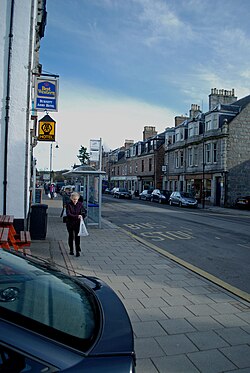Banchory
| Banchory Gaelic: Beannchar | |
| Kincardineshire | |
|---|---|
 Banchory High Street | |
| Location | |
| Grid reference: | NO698958 |
| Location: | 57°3’18"N, 2°29’24"W |
| Data | |
| Population: | 6,034 (2001) |
| Post town: | Banchory |
| Postcode: | AB31 |
| Dialling code: | 01330 |
| Local Government | |
| Council: | Aberdeenshire |
| Parliamentary constituency: |
W. Aberdeenshire & Kincardine |
Banchory is a small town in Kincardineshire at the gateway to Royal Deeside. It is found some 18 miles west of Aberdeen, near where the Feugh River meets the River Dee. The parish of Banchory-Ternan extends to over 20,000 acres, 1,058 of which lie north of the Corrichie Burn which forms the county border with Aberdeenshire.
Banchory is the largest town in the area and trade is centred on its High Street. It has a number of hotels and restaurants including the Stag Hotel, Scott Skinners Bar and Restaurant, the Burnett Arms, and the Douglas Arms. The shops include newsagents, sports shops and chemists.
Since the 1970s, the town has grown steadily. Since 2001 there has been rapid expansion. A large forested area 'the Hill of Banchory', owned by the Burnett family (owners of Crathes Castle), to the north east of the town has been replaced by a large housing estate and an influx of new residents.
Name and origin of the town
The name of Banchory is from the Gaelic Beannchar, meaning "blessed place". It is thought to be derived from an early Christian settlement founded by St Ternan, believed to be a follower of St Ninian and who established a college on the banks of the River Dee to teach Christianity and agriculture to the local Picts. The village and the parish were called Banchory Ternan until the 1970s.
The original Gaelic form is almost identical to that of Bangor, County Down, of similar meaning, and the latter also the site of a monastery. Relics associated with St. Ternan were preserved by hereditary keepers at Banchory until the Reformation]]. Two early Christian cross-slabs survive in or near the old churchyard on the site of the early church. One is built into a corner of the 'mort house' in the churchyard, and shows two crosses incised in a worn pink granite slab. The other is a ringed cross in relief built into the wall facing the main road outside the churchyard.
Land use
As a small rural town, surrounded by forestry and agricultural land, Banchory has seen considerable expansion in recent years. Development pressure continues to be strong and the town's population now exceeds 8,000. As Banchory expands, more demands are placed on local infrastructure such as doctors, dentists, sports facilities, swimming pool and schools. In recent years, the Bellfield Doctor's Surgery, the Fountain Dental Surgery, the Morrisons Supermarket and Banchory Academy have all undergone extended and upgraded facilities. In 2010, Tesco's built an eco-store to the West of the town, it is hoped this will encourage further residential development to this end of the village.
Banchory Academy is a state secondary school, with a school roll of over 950. Despite strong opposition from the local community, a retirement home 'Dalvenie Home' was built on land next to the Academy in the 1990s. The planning process was taken to the Scottish Office where local opposition was overruled. The retirement home opened in 2001 and has restricted expansion of the Academy and the adjacent sports centre.
The pressure for development and the value of land in Banchory means that the Primary and Secondary School Campus area is being considered for sale to housing developers, with sites for a new Academy and a new Primary being investigated.
Churches
Churches in Banchory include:
- Church of Scotland:
- Banchory Ternan East Parish Church (Station Road)
- Banchory Ternan West Parish Church (High Street)
- Independent Evangelical: Banchory Christian Fellowship Church
- Scottish Episcopal Church: St Ternan (High Street), founded in 1851
- Roman Catholic: St Columba's (High Street)
Things in and about the town
As the gateway to Royal Deeside, Banchory attracts many visitors. It is surrounded by lovely rural countryside and attractive hills. For the visitor, the town has much to offer with two famous castles nearby, Crathes Castle and Drum Castle, both run by the National Trust for Scotland.
The Bridge of Feugh offers the chance to see salmon leaping and there are numerous golf courses nearby.[1]
The Banchory show is held every July and attracts a good sized crowd to King George V Park. There is an Agricultural Show, Dog Show, Craft Fair, Highland Dancing Competition and the Scolty Hill Race, as well as traditional fairground stalls and games.[2]
The Royal Deeside Railway originating at Milton of Crathes will shortly run to Banchory; this line is part of the original line to Ballater.
The small town museum recognises that this is the birthplace of James Scott Skinner. Local landmarks include Scolty hill; a hill topped by a tower monument, a memorial to General Burnett who fought alongside Wellington.

Local football teams include Banchory St Ternan, Banchory Boys Club and Banchory Amateurs. It also has the Banchory Beavers swimming team and the Banchory Stags Basketball Club. Banchory has three summer league football teams (Banchory thistle, Banchory youngstars and Banchory stoats) which compete in the mid-Deeside summer league.
Banchory is also home to the widest road-side pavement in the United Kingdom. The section of pavement along Station Road which was formerly a bus-stop before being filled over with tarmac is 17 feet 8 inches in width.
References
- ↑ "Banchory Royal Deeside". http://www.royal-deeside.org.uk/RDvillages/banchory.htm. Retrieved 2007-05-07.
- ↑ "Banchory Show". http://www.agtb.org/4DACTION/WebActionEventDetail/AGRI10538. Retrieved 2007-05-07.